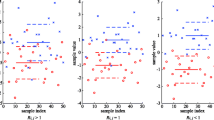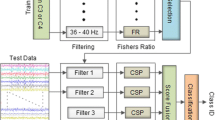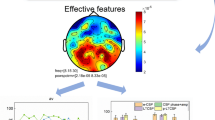Abstract
The extraction methodology of the significant features from the signals is one of the most important pre-requisite steps for EEG signal classification. Common spatial pattern (CSP) is a widely used feature extraction method for EEG signal but with a lacking of failing to maintain discriminative features between classes in the time domain, and further as a consequence, ends up in inconvenience with erroneous output. To overcome the limitations of the convention CSP, this research work proposes a novel frequency domain CSP (FCSP) method for feature extraction. This method proposes to convert the time domain EEG signal to its power spectral density (PSD) so that the event-related variation can be found in the frequency domain. After that, the CSP method is applied to the PSD values of the selected channels to extract the variation based on the spatial pattern of the channels for the events. The output of this method helps to extract simple features from the FCSP-PSD data for the classification. The proposed method is applied to motor imagery data from BCI competition IV. To check the applicability of the proposed method, a complex environment was created considering the same lobe events such as combined left and right feet (Class#1) versus right-hand (Class#2) imagery movement. To compare the performance of the proposed work, the method is also applied to the conventional classification problem (left-hand vs right-hand imagery movement) and found very promising results of 91% accuracy on average.









Similar content being viewed by others
References
Baslow MH. The languages of neurons: an analysis of coding mechanisms by which neurons communicate, learn and store information. Entropy. 2009;11(4):782–97. https://doi.org/10.3390/e11040782.
Baslow MH, Burlina AP. N-acetylaspartate metabolism underlays the structural and functional units of the vertebrate brain: a bioenergetic rationale for clinical observations of changes in the neuronal biomarker “NAA” in many human brain disorders. Bioenergetics. 2012;1(1):1–10. https://doi.org/10.4172/2167-7662.1000102.
Georgieva P, Silva F, Milanova M, Kasabov N. EEG Signal Processing for Brain–Computer Interfaces” Springer handbooks on bio-/neuroinformatics, vol 1, no 46, pp. 797–811, 2014. doi: https://doi.org/10.1007/978-3-642-30574-0_46.
Saha PK, Rahman MA, Mollah MN. Frequency Domain Approach in CSP based Feature Extraction for EEG Signal Classification,” International Conference on Electrical, Computer and Communication Engineering (ECCE), Cox’s Bazar, Bangladesh, 2019, pp. 1–6, https://doi.org/10.1109/ECACE.2019.8679463
Koles ZJ. The quantitative extraction and topographic mapping of the abnormal components in the clinical EEG. Electroencephalogr Clin Neurophysiol. 1991;79(6):440–7. https://doi.org/10.1016/0013-4694(91)90163-X.
Bundy DT, Souders L, Baranyai K, Leonard L, Schalk G, Coker R, Moran DW, Huskey T, Leuthardt EC. Contralesional brain-computer interface control of a powered exoskeleton for motor recovery in chronic stroke survivors. Stroke. 2017;48(8):1908–15. https://doi.org/10.1161/116.016304.
Wriessnegger SC, Brunner C, Müller-Putz GR. Frequency specific cortical dynamics during motor imagery are influenced by prior physical activity. Frontier Physiol. 2018;9:1976. https://doi.org/10.3389/01976.
Lee FY-T, Scherer R, Leeb R, Neuper C, Bischof H, Pfurtscheller G. A comparative analysis of multi-class EEG classification for brain computer interface. Elsvier Computer vision winter workshop, pp. 195–204, 2005.
Chakladar DD, Dey S, Roy PP, Dogra DP. EEG-based mental workload estimation using deep BLSTM-LSTM network and evolutionary algorithm. Biomed Signal Processing Control. 2020. https://doi.org/10.1016/j.bspc.2020.101989.
Saurav S, Chakladar DD, Shaw P, Chakraborty S, Kairi A. Multi-target-based cursor movement in brain-computer interface using CLIQUE clustering, Proceedings of International Ethical Hacking Conference 2018. Advances in Intelligent Systems and Computing, vol 811. Springer, Singapore. doi: https://doi.org/10.1007/978-981-13-1544-2_3
Panda D, Chakladar DD, Dasgupta T. Multimodal system for emotion recognition using EEG and customer review. In: Mandal J, Mukhopadhyay S, eds. Proceedings of the Global AI Congress 2019. Advances in Intelligent Systems and Computing, vol 1112. Springer: Singapore. doi: https://doi.org/10.1007/978-981-15-2188-1_32.
Han C-H, Kim Y-W, Kim SH, Nenadic ZL, Im C-H. Electroencephalography-based endogenous brain–computer interface for online communication with a completely locked-in patient. J Neuro Eng Rehab. 2019;16(18):1–13. https://doi.org/10.1186/12984-019-0493-0.
Raza H, Rathee D, Prasad G, Cecotti H. Current source density estimation enhances the performance of motor-imagery-related brain–computer interface. IEEE Trans Neural Syst Rehabil Eng. 2017;25(12):2461–71. https://doi.org/10.1109/TNSRE.2017.2726779.
Alwasiti HH, Aris I, Jantan A. Brain computer interface design and applications: challenges and future. World Appl Sci J. 2010;11(7):819–25.
Zhang Y, Liu B, Ji X, Huang D. Classification of EEG signals based on autoregressive model and wavelet packet decomposition. Neural Processing Lett. 2017;45(2):365–78. https://doi.org/10.1007/s11063-016-9530-1.
Amin HU, Malik AS, Ahmad RF, Badruddin N, Kamel N, Hussain M, Chooi W-T. Feature extraction and classification for EEG signals using wavelet transform and machine learning techniques. Australas Phys Eng Sci Med. 2015;38(1):139–49. https://doi.org/10.1007/s13246-015-0333-x.
Sherwani F, Shanta S, Ibrahim BSKK, Huq MS. Waveletbased feature extraction for classification of motor imagery signals. IEEE EMBS Conference on Biomedical Engineering and Sciences (IECBES), Kuala Lumpur, pp. 360–364, 2016. https://doi.org/10.1109/IECBES.2016.7843474.
Djemal R, Bazyed AG, Belwafi K, Gannouni S, Kaaniche W. Three-class EEG-based motor imagery classification using phase-space reconstruction technique. Brain Sci. 2016;6(36):1–19. https://doi.org/10.3390/brainsci6030036.
Nazneen T, Rahman MA, Mollah MN. Towards the effective intrinsic mode functions for motor imagery EEG signal classification. International Conference on Electrical, Computer and Communication Engineering (ECCE), Cox’s Bazar, Bangladesh, 7–9 February 2019. https://doi.org/10.1109/ECACE.2019.8679120
Munoz-Gutierrez PA, Giraldo E, Bueno-Lopez M, Molonas M. Localization of active brain sources from EEG signals using empirical mode decomposition: a comparative study. Front Integrative Neurosci. 2018;12(55):1–14. https://doi.org/10.3389/fnint.2018.00055.
Horel JD. Complex principal component analysis: theory and example. J Climate Appl Meteorol. 1984;23:1660–76. https://doi.org/10.1175/1520-0450.
Goksu F, Ince NF, Tewfik AH. Sparse common spatial patterns in brain computer interface applications. IEEE International Conference Acoustics, Speech and Signal Processing (ICASSP), pp. 533–536, 2011. https://doi.org/10.1109/ICASSP.2011.5946458.
Falzon O, Camilleri KP, Muscat J. The analytic common spatial patterns method for EEG-based BCI data. J Neural Eng. 2012;9:1–13. https://doi.org/10.1088/1741-2560/9/4/045009.
Lotte F. A tutorial on EEG signal processing techniques for mental state recognition in brain-computer interfaces. Springer (guide to brain computer music interfacing). 2014; pp. 133–161. https://doi.org/10.1007/978-1-4471-6584-2_7.
Grosse-Wentrup M, Liefhold C, Gramann K, Buss M. Beamforming in noninvasive brain–computer interfaces. IEEE Trans Biomed Eng. 2009;56:1209–19. https://doi.org/10.1109/TBME.2008.2009768.
Kim H, Yoshimura N, Koike Y. Classification of movement intention using independent components of premovement EEG. Front Hum Neurosci. 2019;13(63):1–10. https://doi.org/10.3389/fnhum.2019.00063.
Ha KW, Jeong JW. Motor imagery EEG classification using capsule networks. Sensors. 2019. https://doi.org/10.3390/s19132854.
Tian G, Liu Y. Study on classification of left-right hands motor imagery EEG Signals based on CNN. International Conference on Cognitive Informatics & Cognitive Computing (ICCI*CC), Berkeley, CA, 2018; pp. 324–329. doi: https://doi.org/10.1109/ICCI-CC.2018.848204.
Mendoza PB, Ibarra-Manzano MA, Guerra-Hernandez EI, et al. Improving EEG-based motor imagery classification for real-time applications using the QSA method. Comput Intelligence Neurosci. Article ID 9817305. 2017. 1–16. https://doi.org/10.1155/2017/9817305.
Bashar SK, Bhuiyan MIH. Classification of motor imagery movements using multivariate empirical mode decomposition and short time Fourier transform based hybrid method. Eng Sci Technol. 2016;2016(19):1457–64. https://doi.org/10.1016/j.jestch.2016.04.009.
Bashar SK, Bhuiyan MIH. Identification of motor imagery movements from EEG signals using automatically selected features in the dual tree complex wavelet transform domain. Univ J Biomed Eng. 2015;3(4):30–7. https://doi.org/10.13189/ujbe.2015.030402.
Rahman MA, Khanam F, Hossain MK, Alam MK, Ahmad M. Four class motor imagery EEG signal classification using PCA, WAVELET and two-stage neural network. Int J Adv Comput Sci Appl. 2019;10:1–5. https://doi.org/10.14569/IJACSA.2019.0100562.
Weibo Y, Qiu S, Qi H, Zhang L, Wan B, Ming D. EEG feature comparison and classification of simple and compound limb motor imagery. J Neuroeng Rehabil. 2013. https://doi.org/10.1186/1743-0003-10-106.
Liao K, Xiao R, Gonzalez J, Ding L. Decoding individual finger movements from one hand using human EEG signals. PLoS One. 2014;9(1):e85192.
Rahman MA. Topoplot for B-Alert X-10 9-Channel EEG Signal. MATLAB Central File Exchange. https://www.mathworks.com/matlabcentral/fileexchange/69991-topoplot-for-b-alert-x-10-9-channel-eeg-signal. Retrieved 2 April 2019.
Graz University BCI Competition data sets IV. http://www.bbci.de/competition/iv/
Mammone N, Morabito FC. Enhanced automatic wavelet independent component analysis for electroencephalographic artifact removal. Entropy. 2014;16(12):6553–72.
Kabir MF, Islam SMR, Rahman MA. Accuracy improvement of fNIRS based motor imagery movement classification by standardized common spatial pattern,” 4th International Conference on Electrical Engineering and Information & Communication Technology (ICEEICT), pp. 395–400, 13–15 Sept, 2018, Dhaka, Bangladesh. https://doi.org/10.1109/CEEICT.2018.8628061.
Rahman MA, Ahmad M. Movement related events classification from functional near infrared spectroscopic signal. 19th International Conference on Computer and Information Technology (ICCIT), pp. 207–212, Dhaka, Bangladesh, 2016. https://doi.org/10.1109/ICCITECHN.2016.7860196.
Ahmmed R, Rahman MA, Hossain MF. An advanced algorithm combining SVM and ANN classifiers to categorize tumors with position from brain MRI images. Adv Sci Technol Eng Syst J. 2018;3(2):40–8. https://doi.org/10.25046/aj030205.
Zhao L, He Y. Power spectrum estimation of the welch method based on imagery EEG. Appl Mech Mater. 278–280, pp. 1260–1264, 2013. www.scientific.net/AMM.278-280.1260.
Khanam F, Rahman MA, Ahmad M. Evaluating alpha relative power of EEG signal during psychophysiological activities in Salat. International Conference on Innovations in Science, Engineering and Technology 2018 (ICISET), 27–28 October, 2018, International Islamic University Chittagong (IIUC), Bangladesh, pp. 1–06. https://doi.org/10.1109/ICISET.2018.8745614
Solhjoo S, Moradi MH. Mental task recognition: a comparison between some of classification methods.” In BIOSIGNAL 2004 International EURASIP Conference, pp. 24–26. 2004.
Lemm S, Schafer C, Curio G. BCI competition 2003-data set III: probabilistic modeling of sensorimotor rhythms for classification of imaginary hand movements. IEEE Trans Biomed Eng. 2004;51(6):1077–80. https://doi.org/10.1109/TBME.2004.827076.
Xiangzhou W, Wang A, Zheng S, Lin Y, Yu M. A multiple autocorrelation analysis method for motor imagery EEG feature extraction. In Control and Decision Conference (2014 CCDC), The 26th Chinese, pp. 3000–3004. IEEE: New York 2014. https://doi.org/10.1109/CCDC.2014.6852688
Bashar SK, Hassan AR, Bhuiyan MIH. Identification of motor imagery movements from EEG signals using dual tree complex wavelet transform. International Conference on Advances in Computing, Communications and Informatics (ICACCI), 2015, pp. 290–296.
Acknowledgements
The authors would like to thank Dr. Kai J. Miller and Dr. Gerwin Schalk for providing the data of BCI Competition IV.
Author information
Authors and Affiliations
Contributions
MAR and PKS both contributed equally to generate the idea, data processing, methodology development, MATLAB coding, and result analysis. MKA and AF helped to write the total article and advised to improve the quality of this article. MNM supervised the research work. All the authors finally read the article and gave consent for the publication. All authors read and approved the final manuscript.
Corresponding author
Ethics declarations
Conflict of interest
The authors declare no conflict of interest regarding this publication.
Additional information
Publisher's Note
Springer Nature remains neutral with regard to jurisdictional claims in published maps and institutional affiliations.
Rights and permissions
About this article
Cite this article
Saha, P.K., Rahman, M.A., Alam, M.K. et al. Common Spatial Pattern in Frequency Domain for Feature Extraction and Classification of Multichannel EEG Signals. SN COMPUT. SCI. 2, 149 (2021). https://doi.org/10.1007/s42979-021-00586-9
Received:
Accepted:
Published:
DOI: https://doi.org/10.1007/s42979-021-00586-9




